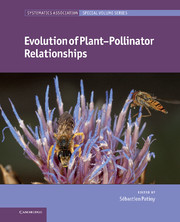Book contents
- Frontmatter
- Contents
- Contributors
- Preface
- 1 Macroevolution for plant reproductive biologists
- 2 Pollination crisis, plant sex systems, and predicting evolutionary trends in attractiveness
- 3 Evolution and ecological implications of “specialized” pollinator rewards
- 4 Fig–fig wasp mutualism: the fall of the strict cospeciation paradigm?
- 5 Fossil bees and their plant associates
- 6 Pollen evidence for the pollination biology of early flowering plants
- 7 Pollinator mediated floral divergence in the absence of pollinator shifts
- 8 Animal pollination and speciation in plants: general mechanisms and examples from the orchids
- 9 Why are floral signals complex? An outline of functional hypotheses
- 10 A survey on pollination modes in cacti and a potential key innovation
- 11 Zygomorphy, area, and the latitudinal biodiversity gradient in angiosperms
- 12 Ambophily and “super generalism” in Ceratonia siliqua (Fabaceae) pollination
- 13 Structure and dynamics of pollination networks: the past, present, and future
- 14 Pollinators as drivers of plant distribution and assemblage into communities
- 15 Effects of alien species on plant–pollinator interactions: how can native plants adapt to changing pollination regimes?
- 16 Pollen resources of non-Apis bees in southern Africa
- 17 Advances in the study of the evolution of plant–pollinator relationships
- Index
- Plate section
- References
6 - Pollen evidence for the pollination biology of early flowering plants
Published online by Cambridge University Press: 05 January 2012
- Frontmatter
- Contents
- Contributors
- Preface
- 1 Macroevolution for plant reproductive biologists
- 2 Pollination crisis, plant sex systems, and predicting evolutionary trends in attractiveness
- 3 Evolution and ecological implications of “specialized” pollinator rewards
- 4 Fig–fig wasp mutualism: the fall of the strict cospeciation paradigm?
- 5 Fossil bees and their plant associates
- 6 Pollen evidence for the pollination biology of early flowering plants
- 7 Pollinator mediated floral divergence in the absence of pollinator shifts
- 8 Animal pollination and speciation in plants: general mechanisms and examples from the orchids
- 9 Why are floral signals complex? An outline of functional hypotheses
- 10 A survey on pollination modes in cacti and a potential key innovation
- 11 Zygomorphy, area, and the latitudinal biodiversity gradient in angiosperms
- 12 Ambophily and “super generalism” in Ceratonia siliqua (Fabaceae) pollination
- 13 Structure and dynamics of pollination networks: the past, present, and future
- 14 Pollinators as drivers of plant distribution and assemblage into communities
- 15 Effects of alien species on plant–pollinator interactions: how can native plants adapt to changing pollination regimes?
- 16 Pollen resources of non-Apis bees in southern Africa
- 17 Advances in the study of the evolution of plant–pollinator relationships
- Index
- Plate section
- References
Summary
Introduction
Angiosperms are the dominant and most diverse plant group living today. They are also found in the greatest number of terrestrial ecosystems on Earth of any group of plants (Judd et al. 2002; Soltis and Soltis 2004). They provide human beings and other terrestrial animals, directly or indirectly, with the majority of their nutrition (e.g. Theissen and Melzer 2007). Much of these foods, such as fruits, nuts, seeds, and grains, are the direct products of flowers, and pollination is an essential step in their formation. Pollination biology has long been an interest of biologists and agricultural scientists (e.g. Faegri and van der Pijl 1979; Proctor et al. 1996; Aizen et al. 2009; Lonsdorf et al. 2009; Mitchell et al. 2009). However, our understanding of the early phases of the evolution of angiosperm pollination is still limited and attempts to reconstruct the history of the interactions between angiosperms and pollinators are challenging (Hu et al. 2008; Taylor and Hu 2010). Evolutionary biologists have attempted to deduce the possible histories of pollination syndromes (summarized in Taylor and Hu, 2010) based upon usually incomplete and limited early angiosperm flower fossil records (e.g. Dilcher 1979; Retallack and Dilcher 1981; Crane et al. 1986; Herendeen et al. 1995; Crepet and Nixon 1996; Friis et al. 1999, 2000, 2006; Crepet 2008), limited insect fossil records(e.g. Grimaldi 1999; Labandeira 2000, 2002; Grimaldi and Engel 2005; Ren et al. 2009), parsimony analysis (e.g. Hu et al. 2008; Friedman and Barrett 2008; Taylor and Hu 2010), investigation on pollination biology of the most basal angiosperms (e.g.Thien et al. 2009), and angiosperm pollen fossil records (e.g. Hu et al. 2008; Taylor and Hu 2010).
Currently there are three hypotheses regarding early angiosperm pollination biology (Taylor and Hu, 2010):
Ancestral angiosperms were insect pollinated (e.g. Crepet and Friis 1987; Wing and Boucher 1998; Friis et al. 1999; Feild and Arens 2005).
During the mid Cretaceous there were increases in advanced pollination syndromes (e.g. Crepet et al. 1991; Crepet 2008; Hu et al. 2008, Taylor and Hu 2010).
Wind pollination (anemophily) is derived (e.g. Culley et al. 2002; Hu et al. 2008, Taylor and Hu 2010).
- Type
- Chapter
- Information
- Evolution of Plant-Pollinator Relationships , pp. 165 - 236Publisher: Cambridge University PressPrint publication year: 2011
References
- 1
- Cited by

